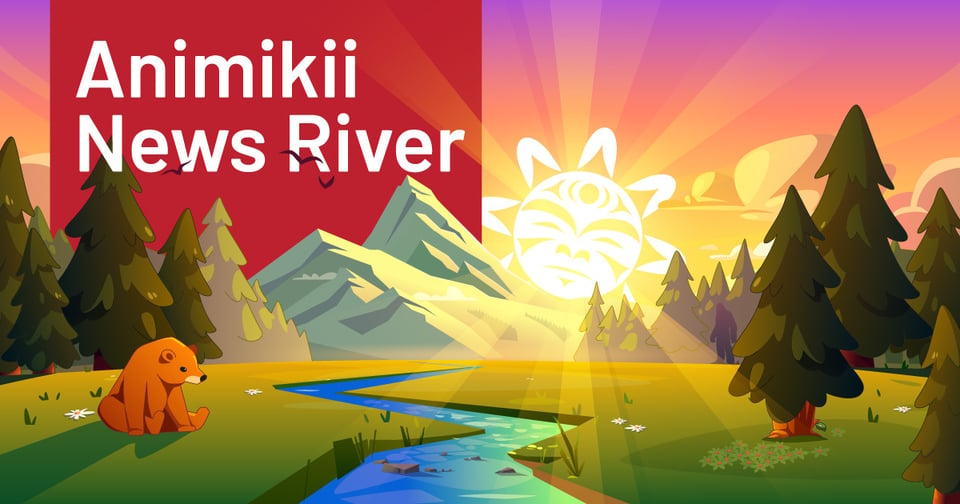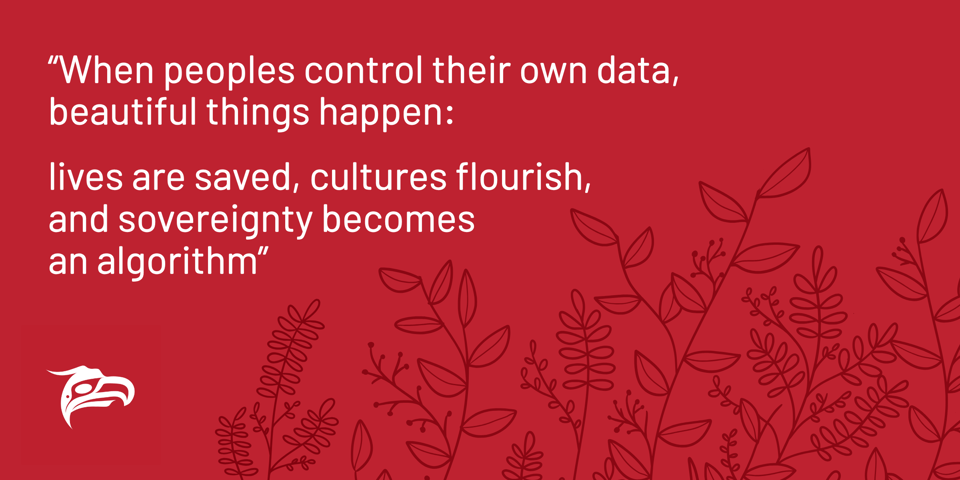Grants you need to know about right now
Decolonizing digital spaces and funding data sovereignty infrastructure.

Boozhoo News River Readers,
We’re entering another season with the autumn equinox happening on Monday, and you’ll notice we have a new friend in the banner image above! Buffalo represents Respect, or Manaaji’idiwin, in the Seven Sacred or Seven Grandfather teachings. Here at Animikii, respect is about honouring the value of ourselves, our team, our clients, our environment, and our work. Buffalo reminds us to honour all our relations.
If you find the stories in this week’s News River insightful - forward this email to a friend or colleague.
Thanks for being here, and here’s the news!
This week’s stories include:
“It’s about bringing the ways of Indigenous people into the mix, and ensuring that research reflects who we are,” says Treena Delormier, at the Indigenous Health Research Summit.
Study suggests Indigenous Territories can safeguard human health depending on the landscape structure and legal status.
“In the digital world, data is like land,” Peter-Lucas Jones explained. “If we do not have control, governance, and ongoing guardianship of our data as indigenous people, we will be landless in the digital world, too.”

Funding Pathways for Indigenous Data Sovereignty Infrastructure
The big picture: Indigenous peoples are reclaiming authority over information that defines them. However, various systems and political forces have collided and have resulted in funding for this work being under threat and Indigenous data facing unprecedented erasure.
Why it matters: Indigenous communities are decolonizing digital spaces on their own terms, notably in the area of language revitalization. Despite the demonstrated health and fiscal success when Indigenous peoples control their own data, this "new era for Indigenous data sovereignty" faces immediate threats.
Key points:
Researchers, academics and people who hold Indigenous data cannot wait: the next 4-6 months are critical to protect funding streams and safeguard health data, research and cultural knowledge from seizure or privatization.
In Canada the 2025 budget is expected to have major cuts to programs related to Indigenous data.
The Trump administration eliminated Indigenous peoples from State Department reports while dismantling DEI programs.
What they’re saying: "The Indigenous data sovereignty movement really is about this notion that there's a role for everybody—for elders, for youth, for scholars," says Stephanie Russo Carroll, who directs the Collaboratory for Indigenous Data Governance at the University of Arizona.
Learn more: Communities must act now to secure available resources before political winds eliminate them entirely. We have collected a list of examples of Nations, communities and organizations accessing funding sources available for various aspects of the Indigenous data sovereignty movement. Read more and see the list here: https://akii.ca/46rLsR9
Curated Articles:
From subjects to leaders: Indigenous communities in Kahnawà:ke driving their own health research
The Indigenous Health Research Summit in Kahnawà:ke is highlighting how communities are taking the lead in shaping research, by Indigenous people, for Indigenous people, to build healthier futures for the next generations. The gathering also marks 30 years of the Kahnawà:ke Schools Diabetes Prevention Project, known as KSDPP. The program began in 1994 after community elders raised concerns about rising rates of Type 2 diabetes. Since then, KSDPP has promoted healthy, active lifestyles for children while weaving together Kanien’kehá:ka values with modern health science. Over the decades, the program has built bridges between researchers, educators and Kahnawà:keró:non, creating one of the first Indigenous community Codes of Research Ethics, a framework that has since been adapted by other First Nations and Inuit communities.
Indigenous Futures in Artificial Intelligence: From Language Sovereignty to Ecological Stewardship
Artificial intelligence is often framed as a frontier that belongs to Silicon Valley, Beijing, or the halls of elite universities. Yet across the globe, Indigenous peoples are shaping AI in ways that reflect their own histories, values, and aspirations. These efforts are not simply about catching up with the latest technological wave—they are about protecting languages, reclaiming data sovereignty, and aligning computation with responsibilities to land and community. Indigenous-led AI initiatives are emerging as powerful acts of cultural resilience and political assertion. They remind us that intelligence—whether artificial or human—must be grounded in relationship, reciprocity, and respect. “In the digital world, data is like land,” Peter-Lucas Jones explained. “If we do not have control, governance, and ongoing guardianship of our data as indigenous people, we will be landless in the digital world, too.”
Preserving Māori language through Ai: Peter Lucas-Jones at Radiodays Asia
At the recent Radiodays Asia conference, Peter Lucas-Jones, CEO of Te Reo Irirangi o Te Hiku o Te Ika (Te Hiku Media), delivered an insightful presentation on the innovative use of Māori language radio broadcasts to train speech and language technologies. The initiative is a significant step towards the preservation and revitalization of the Māori language, leveraging decades of radio broadcasts to develop large language learning models. Peter Lucas-Jones, a seasoned Māori language broadcaster and digital content creator, is at the forefront of this project. He emphasized the importance of Indigenous data sovereignty and the role of natural language processing (NLP) in supporting Indigenous language revitalization. The project, which has been in development for over 30 years, aims to protect and utilize the vast archive of Māori language radio broadcasts. “We are protectors of data. We have the largest archive in the tribal radio network.”
Indigenous Territories are crucial for preserving biodiversity, particularly in tropical regions, yet their contribution to human health is poorly understood. Using 20 years of data on fire-related and zoonotic/vector-borne diseases, we evaluated how Indigenous Territories, their legal recognition status, and landscape parameters affected disease incidence in the Amazon biome. Overall, we found that Indigenous Territories extent had complex and non-linear effects, with a potential to reduce fire-related disease incidence and to increase zoonotic/vector-borne diseases, depending on the local landscape structure.Our findings emphasize the complex relationships between conservation and human health, which vary based on the local context and Indigenous Territories legal recognition, and underscores the importance of Indigenous Territories and their legal acknowledgment for supporting ecosystem and human health, particularly in landscapes with high forest integrity and low fragmentation.
Deep in the Amazon, sound designer Eric Terena has been capturing the sounds of the rainforest while sitting silently beneath the dense, towering treetops with his recording equipment. He has noticed some huge changes. “What the environment once spoke, what biodiversity once sang, has shifted to sounds from industrial projects that have arrived in our territories,” said Terena, co-founder of Mídia Indígena, a Brazilian media and communications network which promotes and preserves Indigenous cultures. His words describe more than a change in sound – they show how nature is gradually being replaced by machines. Ancestral songs have been drowned out by industrial noise. Terena shares these changes using digital tools to bring local stories to global audiences, turning lived experience into climate knowledge.
Fighting for a just and sustainable AI future
The environmental costs of AI are real, but so are the opportunities to build systems that prioritize people and the planet. Artificial intelligence is everywhere. It writes emails, recommends shows, powers online searches and drives major innovations in health care, finance and education. Behind the buzz, though, lies a hidden reality: AI is not weightless. The tools many of us interact with every day, whether a chatbot or an image generator, require enormous amounts of electricity, water and physical infrastructure to function. Far from immaterial, AI has a growing environmental footprint with real consequences for people, communities and ecosystems. For LGBTQ+ readers, the climate story is not separate from the story of technology. Just as AI can amplify bias and harm against queer and trans communities, its environmental costs fall disproportionately on vulnerable groups already on the frontlines of climate change, health inequities, and systemic discrimination. To understand what ethical AI should mean, we must look beyond algorithms to their environmental impact.

Add a comment: